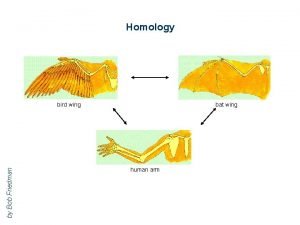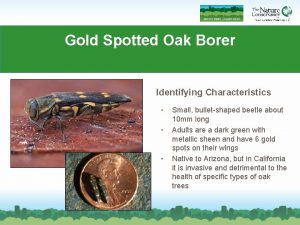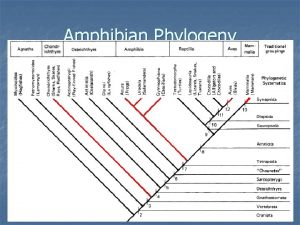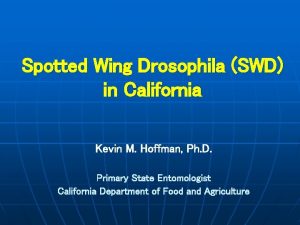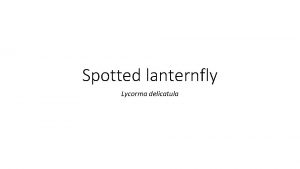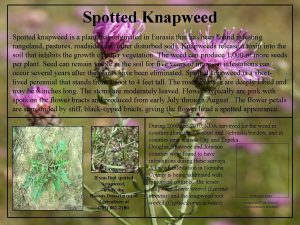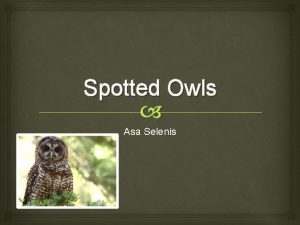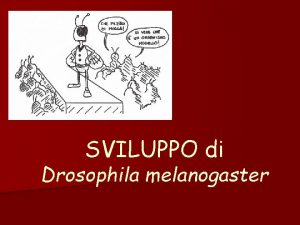Spotted Wing Drosophila SWD in California Kevin M








- Slides: 8

Spotted Wing Drosophila (SWD) in California Kevin M. Hoffman, Ph. D. Primary State Entomologist California Department of Food and Agriculture

Spotted Wing Drosophila (SWD) Drosophila suzukii § Originally from Asia (China, Japan, Korea, Thailand). It has become established in Hawaii and Spain in recent years. § Collected in California for the first time in September 2008, in Santa Cruz County, but its significance was not fully known. § Reports of cherry damage occurred in May 2009. § Subsequent examination of yeastbaited exotic fruit fly Mc. Phail traps revealed adults in several counties. SWD Male on Raspberry (Photo by Ed Show)

Distribution in California & Elsewhere § SWD has now been confirmed from 21 counties: Alameda, Contra Costa, Fresno, Los Angeles, Merced, Napa, Orange, Riverside, Sacramento, San Benito, San Bernardino, San Diego, San Joaquin, San Luis Obispo, San Mateo, Santa Barbara, Santa Clara, Santa Cruz, Stanislaus, Ventura, and Yolo. § Suspect larvae have also been collected in Humboldt, Kings, Madera, Marin, and Solano counties. § Larvae in cherries intercepted at CDFA’s border stations and reportedly homegrown in Oregon and larvae intercepted as reportedly coming from Colorado, Washington, British Columbia, and Alberta have also been found to be consistent with SWD DNA. § However, the actual origin of these intercepted cherries is unconfirmed.

SWD Life Stages - Adult The general appearance of SWD resembles the common vinegar flies in the genus Drosophila, but males differ from other native Drosophila males by possessing a dark spot along the front edge of the wing near the wingtip. Females lack this spot. Otherwise, the fly has the usual Drosophila-like red eyes, pale brown thorax, and pale brown abdomen with black horizontal stripes. It is small, reaching only 2 -3 mm in body length. SWD Male

SWD Life Stages - Immatures § Eggs are very small, white, oblong, with paired filaments at one end. § Larvae are white, legless maggots, with prominent respiratory tubes at the posterior end. § Pupae are yellowish and have paired respiratory tubes protruding at both ends.

SWD Development § Females lay eggs preferentially in ripe and ripening host fruit by using their saw-like ovipositor, but are also considered able to develop in decaying matter. § Females lay 2 -3 eggs per cherry, and have a lifetime fecundity greater than 350. The egg stage lasts up to 72 hours, although eggs may hatch within a day during warmer months. Larvae mature in 3 -13 days. Larvae usually pupate in the fruit but may occasionally enter the soil. Pupation lasts between 3 -15 days. As many as 65 adults have been observed emerging from a single cherry in Asia. One generation takes 12 days at 79°. § SWD has a high reproductive rate, completing up 13 -15 generations per year in its native range. Adults are most active at 68°F and show reduced activity at 86°. Research suggests that eggs and larvae are killed when exposed to approximately 32°F for four days. Female ovipositor Mating Pair (Photo by Ed Show)

SWD Damage § § In Asia, SWD has been reported damaging primarily cherries, but has also been recorded infesting other thin skinned fruits, namely apple, blueberry, grape, peach, persimmon, and plum. Up to 3 generations per season resulting in 75% infestation on cherries was noted in the 1930’s. In California, SWD has been reported infesting fresh cherries, raspberries, and strawberries. Larvae in Raspberry (Photo by Ed Show)

Responses to SWD § Based on the widespread distribution of SWD in California, CDFA has proposed a permanent pest rating of C, meaning that the State will undertake no control or regulatory actions. § USDA is currently taking no regulatory action against SWD. § USDA has asked the southern states that trap for exotic fruit flies to screen their Mc. Phail and other protein bait traps for SWD. § The USDA New Pest Advisory Group is reviewing SWD in regards to future actions by USDA and international trade ramifications. Mc. Phail Trap
